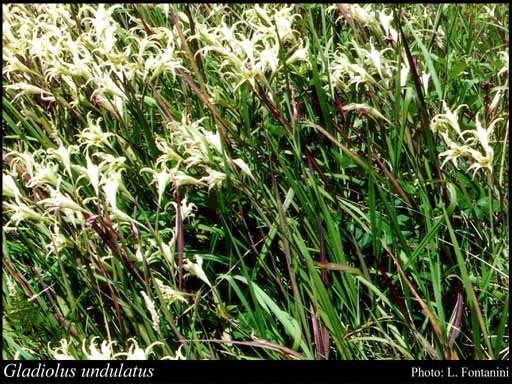- Reference
- Mant.Pl. 27-28 (1767)
- Conservation Code
- Not threatened
- Naturalised Status
- Alien to Western Australia
- Name Status
- Current
Cormous, perennial, herb, 0.4-1.4 m high. Fl. white-cream-green, Oct to Dec. Sand, loam, sandy clay, wet soils. Roadsides.

Distribution
- IBRA Regions
- Jarrah Forest, Swan Coastal Plain, Warren.
- IBRA Subregions
- Northern Jarrah Forest, Perth, Southern Jarrah Forest, Warren.
- IMCRA Regions
- WA South Coast.
- Local Government Areas (LGAs)
- Albany, Armadale, Bassendean, Bridgetown-Greenbushes, Bunbury, Busselton, Chittering, Dardanup, Denmark, Donnybrook-Balingup, Kalamunda, Manjimup, Mundaring, Murray, Nannup, Nedlands, Plantagenet, South Perth, Swan.
Management Notes (for the Swan NRM Region)
General Biology. Growth form. Geophyte. Life form. Annually renewed corm. Reproduction. Primarily cormels, occasionally offsets. Dispersal. Soil, water. Seedbank persistence. Medium, 1-5 years. Fire response. Fire tends to reduce the number of adult plants and facilitate germination of previously dormant cormels, resulting in a significant increase in juveniles.
Notes. Corm exhaustion occurs in July/August while flowering occurs in December. This is unusual as in most geophytes in the family Iridaceae flowering coincides with corm exhaustion. Does not appear to set seed in south-western Australia. In South Africa it is pollinated by long-probiscid flies and does not have the capacity to self pollinate.
Additional information. History of use/introduction. Garden escape. Similar exotic species. Gladiolus angustus.
Suggested method of management and control. Spot spray metsulfuron methyl 0.2 g/15 L + Pulse® or 2.5-5 g/ha + Pulse®. Herbicide application should be just on corm exhaustion. Physical removal can result in spread of cormels. Once the parent corm is killed cormels in the soil tend to lose dormancy and germinate. Read the manufacturers' labels and material safety data sheets before using herbicides. For further information consult the Australian Pesticides and Veterinary Medicines Authority to determine the status of permits for your situation or state.
Management Calendar
| Calendar Type | Jan | Feb | Mar | Apr | May | Jun | Jul | Aug | Sep | Oct | Nov | Dec | Comments |
|---|---|---|---|---|---|---|---|---|---|---|---|---|---|
| Dormant | Y | Y | Y | ||||||||||
| Active Growth | Y | Y | Y | Y | Y | Y | Y | Y | Y | ||||
| Flowering | Y | Y | |||||||||||
| Optimum Treatment | Y |
Legend: Y = Yes, regularly, O = Occasionally, U = Uncertain, referred by others but not confirmed.
References
- Brown, K. & Brooks, K. (2002) Bushland Weeds: A Practical Guide to their Management. Environmental Weeds Action Network, Greenwood.
- Goldblatt, P. & Manning, J.C. (1999) The Long-Proboscid Fly Pollination System in Gladiolus (Iridaceae). Annals of the Missouri Botanical Garden, 86 (3): 758-774.
- Goldblatt, P. & Manning, J. (1998) Gladiolus in Southern Africa. Fernwood Press, Vlaeberg, South Africa.
- Hussey, B.M.J., Keighery, G.J., Dodd, J., Lloyd, S.G. & Cousens, R.D. (2007) Western Weeds. A guide to the weeds of Western Australia. 2nd Edition. The Plant Protection Society of Western Australia, Victoria Park.